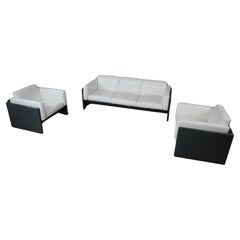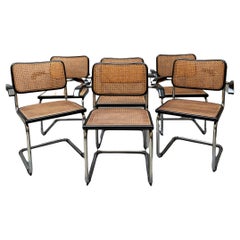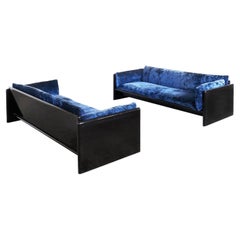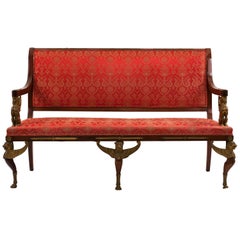Dino Gavina Living Room Sets
3
to
3
3
3
3
1
3
2
1
1
Height
to
Width
to
Depth
to
1
1
1
2
1
1
1
1
3
3
15
61
48
40
27
Creator: Dino Gavina
Arnolfo sofa set by Mauro Marzocchi for Simon International, 1971
By Simon International, Dino Gavina
Located in Langemark-Poelkapelle, BE
"Arnolfo" sofa set by Mauro Marzocchi for Simon International, 1971 Italy.
Grey lacquered high gloss wooden frame and original upholstery in stunning white leather!
The set features...
Category
Late 20th Century Italian Minimalist Dino Gavina Living Room Sets
Materials
Leather, Wood
Set of 6 Cesca
By Dino Gavina
Located in Milano, Lombardia
Armchairs stuffed in natural painted beech, or black lacquered. The scaffolding, in Vienna straw, is carried out by hand. Iconic project of the twentieth century, we propose a set of 6...
Category
1930s Italian Modern Vintage Dino Gavina Living Room Sets
Materials
Metal
Dino Gavina Pair of Blue Velvet 'Simone' Sofas for Studio Simon, 1971
By Studio Simon, Dino Gavina
Located in Tilburg, NL
Dino Gavina (1922-2007) rare pair of blue velvet 'Simone' sofas for Studio Simon 1971. Black lacquered high gloss wooden frame and blue velvet upholstery.
Striking pair of sofas ...
Category
Mid-20th Century Italian Post-Modern Dino Gavina Living Room Sets
Materials
Fabric, Velvet, Wood, Lacquer
Related Items
Set of 5 French Empire Mahogany Living Room Set
Located in New York, NY
Set of 5 French Empire-style (19th century) mahogany salon or living room set with bronze trim and red damask upholstery.
Measurements:
2 arms 27½" W 28" D 40½" H
2 sides 22½...
Category
19th Century Empire Antique Dino Gavina Living Room Sets
Materials
Bronze
Mario Bellini "Le Bambole" Sofa for B&B Italia, Faux-Fur, 1971, Set of 2
By B&B Italia, Mario Bellini
Located in Lonigo, Veneto
Mario Bellini “Le Bambole” two-seater sofa for B&B Italia, Mongolian faux-fur, Italy, 1971, set of two.
This is a timeless Postmodern design icon. The starting point was a shopping ...
Category
1970s Italian Mid-Century Modern Vintage Dino Gavina Living Room Sets
Materials
Iron
H 29.53 in W 63 in D 33.47 in
Black Leather Simone Armchair by Ufficio Progetti Gavina for Simon International
By Studio Simon, Ufficio Progetti Gavina, Dino Gavina
Located in Escalona, Toledo
Simone model armchair, designed by Dino Gavina and produced by Studio Simon in Italy in the 70s.
Structure in solid wood lacquered in gloss black.
Black leather upholstery in very ...
Category
Mid-20th Century Italian Mid-Century Modern Dino Gavina Living Room Sets
Materials
Leather, Beech
H 26.78 in W 36.62 in D 32.29 in
Set of 4 Seats Biedermeier Style
By Malvezzi
Located in Milan, IT
Set of four Biedermeier style seats, crafted from solid walnut wood with a veneering in the same wood, consummately finished to achieve an antique look. The foam rubber padding is in...
Category
2010s Italian Biedermeier Dino Gavina Living Room Sets
Materials
Velvet, Walnut
Set of 4 Seats Biedermeier Sedi Vener
By Malvezzi
Located in Milan, IT
Exquisite set of four Biedermeier style seats in solid walnut wood with a veneering in the same wood in a medium shade, finished with handmade polished shellac and a blue velvet seat...
Category
2010s Italian Biedermeier Dino Gavina Living Room Sets
Materials
Velvet, Walnut
Carlo Scarpa Iroko Wood and Green Velvet Cornaro Sofa for Studio Simon, 1974
By Studio Simon, Carlo Scarpa
Located in Vicenza, IT
Cornaro two-seater sofa, designed by Carlo Scarpa and manufactured by Studio Simon in 1974.
Made of Iroko wood, foam, and azure chenille velvet.
Excellent vintage condition.
Born in Venice on June 2nd, 1906, Carlo Scarpa began working very early. Only a year after he had first qualified as an architect in 1926, he began working for the Murano glassmakers Cappellin & Co. in a consultative capacity; from 1927, he began to experiment with the Murano glass, and this research not only gave him excellent results here but would also inform his progress for many years to come. Between 1935 and 1937, as he entered his thirties, Carlo Scarpa accepted his first important commission, the renovation of Venice’s Cà Foscari. He adapted the spaces of this stately University building which stands on the banks of the Grand Canal, creating rooms for the Dean’s offices and a new hall for academic ceremonies; Mario Sironi and Mario De Luigi were charged with doing the restoration work on the frescos. After 1945, Carlo Scarpa was constantly busy with new commissions, including various furnishings and designs for the renovation of Venice’s Hotel Bauer and designing a tall building in Padua and a residential area in Feltre, all worth mentioning. One of his key works, despite its relatively modest diminished proportions, was the first of many works which were to follow in the nineteen fifties: the [bookshop known as the] Padiglione del Libro, which stands in Venice’s Giardini di Castello and shows clearly Scarpa’s passion for the works of Frank Lloyd Wright. In the years which were to follow, after he had met the American architect, Scarpa repeated similar experiments on other occasions, as can be seen, in particular, in the sketches he drew up in 1953 for villa Zoppas in Conegliano, which show some of his most promising work. However, this work unfortunately never came to fruition. Carlo Scarpa later created three museum layouts to prove pivotal in how twentieth-century museums were set up from then on. Between 1955 and 1957, he completed extension work on Treviso’s Gipsoteca Canoviana [the museum that houses Canova’s sculptures] in Possagno, taking a similar experimental approach to the one he used for the Venezuelan Pavilion at [Venice’s] Giardini di Castello which he was building at the same time (1954-56). In Possagno Carlo Scarpa was to create one of his most incredible ever works, which inevitably bears comparison with two other museum layouts that he was working on over the same period, those of the Galleria Nazionale di Sicilia, housed in the Palazzo Abatellis in Palermo (1953-55) and at the Castelvecchio in Verona (1957- 1974), all of which were highly acclaimed, adding to his growing fame. Two other buildings, which are beautifully arranged in spatial terms, can be added to this long list of key works that were started and, in some cases, even completed during the nineteen fifties. After winning the Olivetti Award for architecture in 1956, Scarpa began work in Venice’s Piazza San Marco on an area destined to house products made by the Industrial manufacturers Ivrea. Over the same period (1959-1963), he also worked on renovating and restoring the gardens and ground floor of the Fondazione Querini Stampalia in Venice, which many consider one of his greatest works. While he worked on-site at the Fondazione Querini Stampalia, Carlo Scarpa also began building a villa in Udine for the Veritti family. To shed some light on how much his work evolved over the years, it may be useful to compare this work with that of his very last building, villa Ottolenghi Bardolino, which was near completion at the time of his sudden death in 1978. Upon completion of villa Veritti over the next ten years, without ever letting up on his work on renovation and layouts, Scarpa accepted some highly challenging commissions which were to make the most of his formal skills, working on the Carlo Felice Theatre in Genoa as well as another theatre in Vicenza.
Towards the end of this decade, in 1969, Rina Brion commissioned Carlo Scarpa to build the Brion Mausoleum in San Vito d’Altivole (Treviso), a piece he continued to work on right up until the moment of his death. Nevertheless, even though he was totally absorbed by work on this mausoleum, plenty of other episodes can offer some insight into the final years of his career. As work on the San Vito d’Altivole Mausoleum began to lessen in 1973, Carlo Scarpa started building the new headquarters for the Banca Popolare di Verona. He drew up plans that were surprisingly different from the work he carried out simultaneously on the villa Ottolenghi. However, the plans Carlo Scarpa drew up, at different times, for a monument in Brescia’s Piazza della Loggia commemorating victims of the terrorist attack on May 28th, 1974, make a sharp contrast to the work he carried out in Verona, almost as if there is a certain hesitation after so many mannered excesses. The same Pietas that informs his designs for the Piazza Della Loggia can also be seen in the presence of the water that flows through the Brion Mausoleum, almost as if to give a concrete manifestation of pity in this twentieth-century work of art. Carlo Scarpa has put together a highly sophisticated collection of structures occupying the mausoleum’s L-shaped space stretching across both sides of the old San Vito d’Altivole cemetery. A myriad of different forms and an equally large number of different pieces, all of which are separate and yet inextricably linked to form a chain that seems to offer no promise of continuity, arising out of these are those whose only justification for being there is to bear the warning “si vis vitam, para mortem,” [if you wish to experience life prepare for death] as if to tell a tale that suggests the circle of time, joining together the commemoration of the dead with a celebration of life. At the entrance of the Brion Mausoleum stand the “propylaea,” followed by a cloister that ends by a small chapel, with an arcosolium bearing the family sarcophagi, the central pavilion, held in place on broken cast iron supports, stands over a mirror-shaped stretch of water and occupies one end of the family’s burial space. The musical sound of the walkways, teamed with the luminosity of these harmoniously blended spaces, shows how, in keeping with his strong sense of vision, Carlo Scarpa could make the most of all his many skills to come up with this truly magnificent space. As well as an outstanding commitment to architectural work, with the many projects we have already seen punctuating his career, Carlo Scarpa also made many equally important forays into the world of applied arts. Between 1926 and 1931, he worked for the Murano glassmakers Cappellin, later taking what he had learned with him when he went to work for the glassmakers Venini from 1933 until the 1950s. The story of how he came to work on furniture design is different, however, and began with the furniture he designed to replace lost furnishings during his renovation of Cà Foscari. The later mass-produced furniture started differently, given that many pieces were originally one-off designs “made to measure.” Industrial manufacturing using these designs as prototypes came into being thanks to the continuity afforded him by Dino Gavina, who, as well as this, also invited Carlo Scarpa to become president of the company Gavina SpA, later to become SIMON, a company Gavina founded eight years on, in partnership with Maria Simoncini (whose own name accounts for the choice of company name). Carlo Scarpa and Gavina forged a strong bond in 1968 as they began to put various models of his into production for Simon, such as the “Doge” table, which also formed the basis for the “Sarpi” and “Florian” tables. In the early seventies, other tables that followed included “Valmarana,” “Quatour,” and “Orseolo.” While in 1974, they added a couch and armchair, “Cornaro,” to the collection and the “Toledo” bed...
Category
1970s Italian Mid-Century Modern Vintage Dino Gavina Living Room Sets
Materials
Velvet, Foam, Chenille, Wood
H 25.6 in W 86.62 in D 34.26 in
Simon Gavina Black Lacquer Sofa Sette Pink Velvet, Italy, 1970s
By Dino Gavina
Located in New York, NY
Simon Gavina black lacquer sofa sette pink velvet, Italy, 1970s
Gorgeous chic black and pink sofa/settee newly upholstered in light pink fabric.
...
Category
1970s Italian Mid-Century Modern Vintage Dino Gavina Living Room Sets
Materials
Velvet, Wood, Lacquer
Set of Vintage Brutalist Sofa's, 1970s
Located in HEVERLEE, BE
Vintage Brutalist three seater sofa with matching armchair in oak and black leather.
The sofa's are very comfortable and have a nice brutalist design.
Good condition.
1970s ...
Category
1970s German Brutalist Vintage Dino Gavina Living Room Sets
Materials
Leather, Oak
Studio Simon Black Wood and Azure Velvet Two-Seater “Simone” Sofa, Italy, 1975
By Studio Simon
Located in Vicenza, IT
Two-seater “Simone” sofa, designed and manufactured by Studio Simon in 1975.
The structure is made of black lacquered wood. An azure velvet big seat completes the sofa.
The min...
Category
1970s Italian Mid-Century Modern Vintage Dino Gavina Living Room Sets
Materials
Cotton, Velvet, Foam
H 20.48 in W 61.82 in D 31.89 in
Dino Gavina for Studio Simon, Andy Warhol Campbell’s Soup Can Stool, Italy, 1971
By Studio Simon, Dino Gavina
Located in Brooklyn, NY
Dino Gavina for Studio Simon, Homage to Andy Warhol: Campbell’s soup can stool, Italy, 1971.
Rare stool designed by Dino Gavina as a tribute to Andy Wa...
Category
1970s Italian Mid-Century Modern Vintage Dino Gavina Living Room Sets
Materials
Metal
Simone Sofa by Dino Gavina for Studio Simon
By Simon Gavina Editions
Located in San Pietro di Morubio, Verona
Dino Gavina "Simone" sofa for Studio Simon, Italian production of the 1970s.
Category
1970s Italian Mid-Century Modern Vintage Dino Gavina Living Room Sets
Materials
Fabric, Plywood
Contemporary Modern Jacob Sofa in Green Velvet Fabric by Collector Studio
Located in Castelo da Maia, PT
Contemporary Modern Collector Studio Jacob sofa in green velvet by Collector
This fun and sophisticated 21st century sofa designed by Collector S...
Category
2010s Portuguese Dino Gavina Living Room Sets
Materials
Fabric
H 29.5 in W 118.1 in D 35.4 in
Previously Available Items
Dino Gavina Pair of Blue Velvet 'Simone' Sofas for Studio Simon, 1971
By Studio Simon, Dino Gavina
Located in Tilburg, NL
Dino Gavina (1922-2007) rare pair of blue velvet 'Simone' sofas for Studio Simon 1971. Black lacquered high gloss wooden frame and blue velvet upholstery.
Striking pair of sofas ...
Category
Mid-20th Century Italian Post-Modern Dino Gavina Living Room Sets
Materials
Fabric, Velvet, Wood, Lacquer
H 22.45 in W 84.26 in D 31.5 in
Dino Gavina "Simone" Armchairs for Studio Gavina, 1971, Set of Two
By Dino Gavina, Simon Gavina Editions
Located in Lonigo, Veneto
Dino Gavina "Simone" armchairs for Studio Gavina, 1971, set of two
Italian pair of "Simone" lounge chairs, designed by Dino Gavina and produced by Simon Gavina in 1971. The set is i...
Category
1970s Italian Mid-Century Modern Vintage Dino Gavina Living Room Sets
Materials
Velvet, Wood
Dino Gavina "Simone" Sofa for Studio Gavina, 1971
By Dino Gavina, Simon Gavina Editions
Located in Lonigo, Veneto
Dino Gavina "Simone" sofa for Studio Gavina. Black lacquered frame and green velvet cushions, 1971.
Available the complete living room set composed of:
- A pair of two-seat sofas;
-...
Category
1970s Italian Mid-Century Modern Vintage Dino Gavina Living Room Sets
Materials
Wood, Velvet
"Simone" Sofa Set by Dino Gavina, circa 1971, Italy
By Dino Gavina
Located in Melbourne, VIC
Rare pair of "Simone" sofas by Studio Simon Gavina. Black lacquered timber frame and original red leather upholstery. 1971, Italy.
Category
Mid-20th Century Italian Mid-Century Modern Dino Gavina Living Room Sets
Dino Gavina living room sets for sale on 1stDibs.
Dino Gavina living room sets are available for sale on 1stDibs. These distinctive items are frequently made of wood and are designed with extraordinary care. There are many options to choose from in our collection of Dino Gavina living room sets, although brown editions of this piece are particularly popular. Many of the original living room sets by Dino Gavina were created in the modern style in italy during the mid-20th century. Prices for Dino Gavina living room sets can differ depending upon size, time period and other attributes — on 1stDibs, these items begin at $5,540 and can go as high as $9,800, while a piece like these, on average, fetch $7,670.





